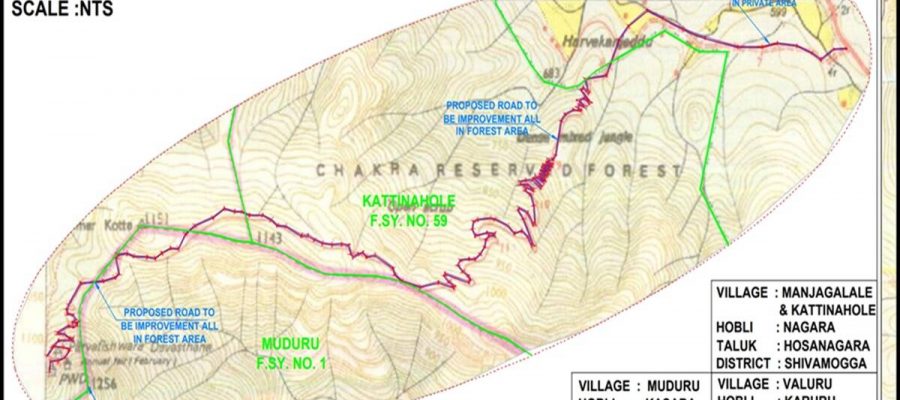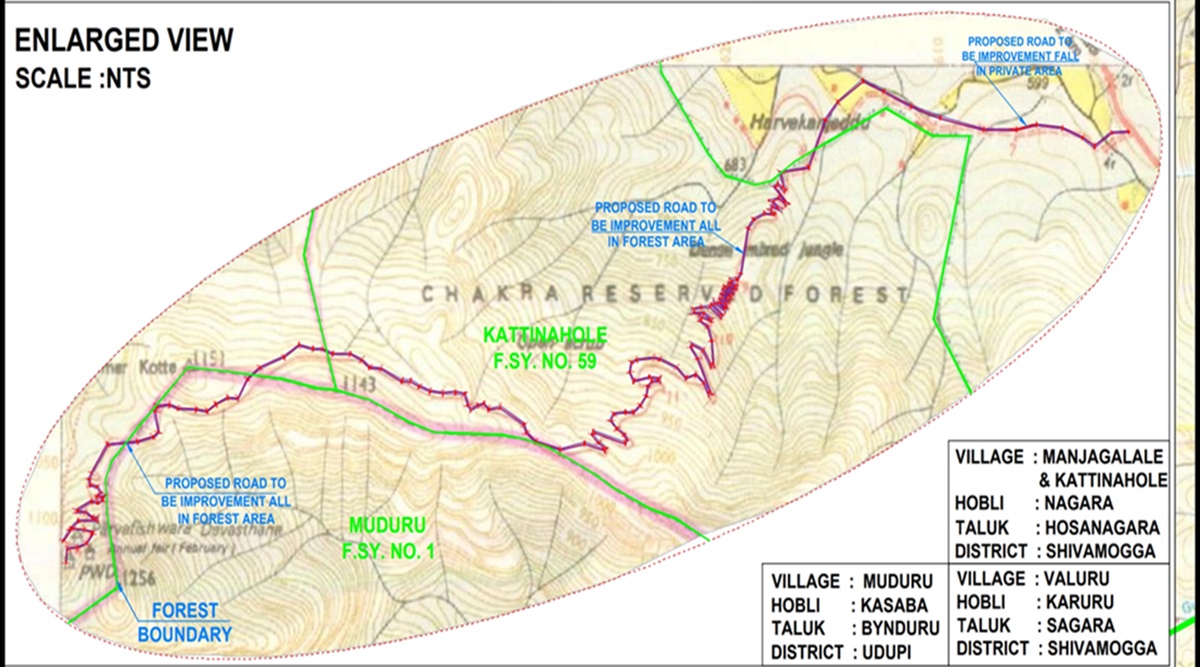One of the major concerns of environmentalists is that the project falls in the eco-sensitive zone of the Mookambika Wildlife Sanctuary. The KRDCL has sought the diversion of 5.50 hectares of fresh forest area land and 0.0676 hectares of non-forest land for the project.
A proposal by the Karnataka Road Development Corporation Limited (KRDCL) to build a concrete road to the Kodachadri hills, a popular trekking destination, cutting through the Mookambika Wildlife Sanctuary in Shimoga, has raised environmental concerns.
The Rs 9.74 crore proposal is now before the standing committee of the National Board of Wildlife (NBWL) and Ministry of Environment Forest and Climate Change for clearance.
The road project is proposed to pass through Kodachadri reserve forest, Chakra forest and Madibare reserve forest.
The KRDCL has sought the diversion of 5.50 hectares of fresh forest area land and 0.0676 hectares of non-forest land for “improvement of mud road to cement concrete road from Kattinahole to Kodachadri hilltop and Chakra forest”.
One of the major concerns of environmentalists is that the project falls in the eco-sensitive zone of the Mookambika Wildlife Sanctuary. Out of the total proposed area for diversion, 4.5 hectares belongs to the Mookambika Wildlife Sanctuary, which falls under the Kudremukh wildlife division, and 0.99 hectares comes under the Sagar division.
The proposed concrete road would jeopardise the lives of vulnerable species, including leopards and sloth bears, and endangered species like the lion-tailed macaque, environmentalists argue.
According to the minutes of a meeting of the Karnataka State Board for Wildlife, accessed by The Indian Express, in January 2021, it recommended that the Kodachadri road project proposal must be sent to MoEFCC for approvals.
An environmentalist working out of Shivamogga, speaking on the condition of anonymity, said that the ‘Right of Way’ was only two metres of footpath used by people and cattle. “Sometime in 2007, the footpath was converted into a mud road of 5 metres which was illegal as this cuts across Mookambika Wildlife Sanctuary. Now this mud road is being proposed to be concretised. The wildlife activists have stated the project violates the Wildlife Protection Act,” the activist said.
“The notification of Kodachadri reserve forest, Chakra state forest and Madibare reserve forest does not mention the right of way for this road and instead it is mentioned as a footpath only. Hence, the existing road itself is illegal,” he said.
The detailed project report (DPR) by the KRDCL clearly states the project is being undertaken to boost tourism. “Kodachadri receives an annual rainfall of 500 cm to 750 cm and it rains for about eight months in a year. During monsoons, due to heavy rains, the existing route becomes slippery. This hill road between Kattinahole and Kodachadri hill is in very poor condition with poor geometrics (inadequate radii of horizontal curves, several hairpin bends, inadequate sight distance, steep gradients and inadequate road widths). Only Jeeps driven by skilled drivers can use the hill road and no other vehicle can use this road,” the DPR reads.
KRDCL in August 2020 wrote a justification letter, an excerpt of which reads: “The rain forest looms in a perpetual layer of mist around the peak. An inspection bungalow constructed by the Karnataka public work department is located on the top of the hill (opened in 1999). Provision of adequate infrastructure in the terms of proper road linkage to the state highway, restaurants, lodges/ cottages and other amenities will go a long way in making Kodachadri hill a preferred destination for tourists/trekkers/pilgrims”.
Apart from this Kodachadri has the potential of providing a calm and peaceful place for urban dwellers, KRDCL said.
The land suitability certificate of August 7, 2020, issued by the Sagar deputy conservator of forest shows the Karnataka forest department has accepted the diversion of the forest area to boost tourism.
Former principal chief conservator of forest (head of forest force), Karnataka, BK Singh said that the destruction of Western Ghats to elevate tourism is not a healthy step for conservation of forests and wildlife. “Low-key tourism is already in place and any upgrade would increase tourism beyond the carrying capacity which would be disastrous,” he said.
Section 29 of the Wildlife Protection Act restricts any non-forestry activity inside a protected area unless it is for the betterment of the wildlife sanctuary or a national park. However, the department is allowed to build water holes, tanks, bunds which are pre-requisites for the conservation and protection of the wildlife.
Source: Read Full Article


